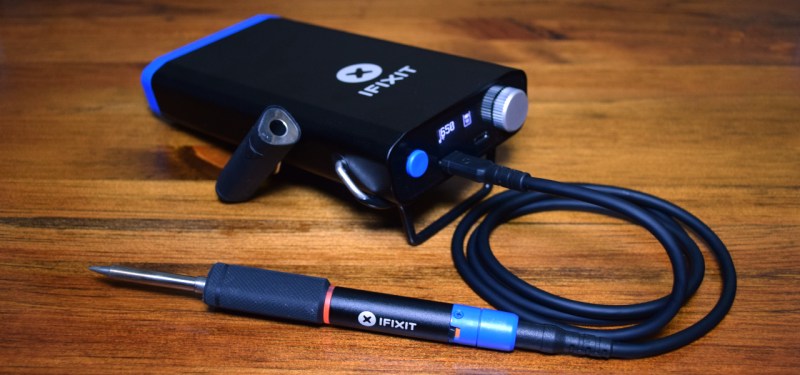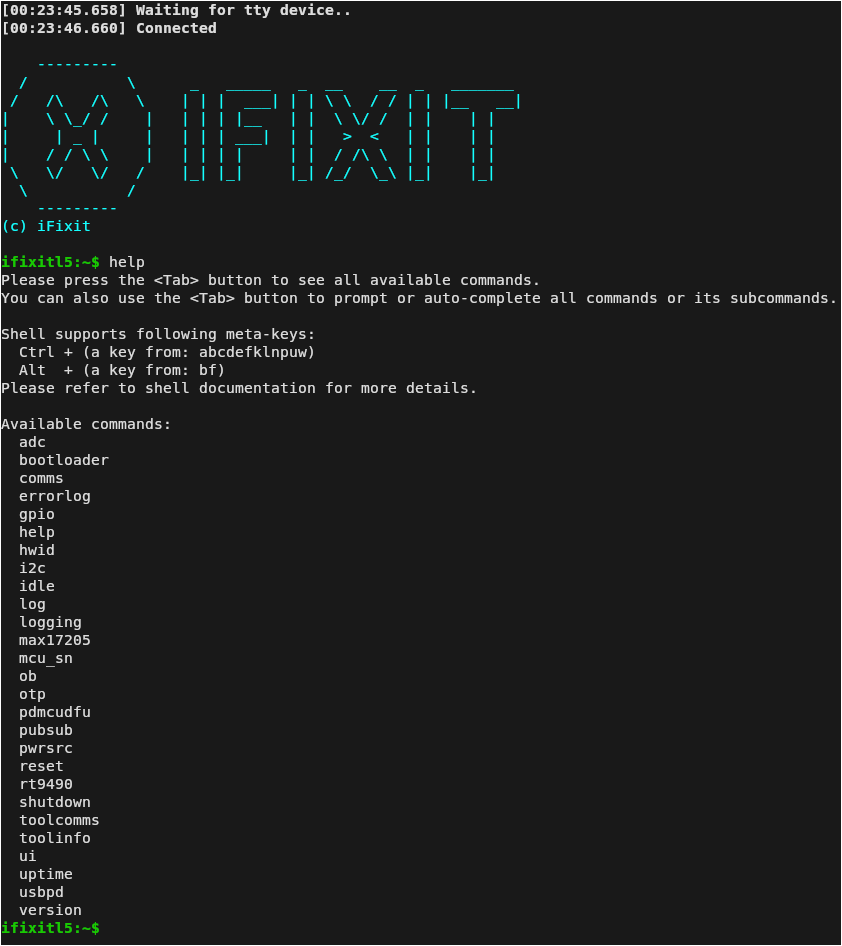When we reviewed the iFixit FixHub back in September, one of the most interesting features of the portable soldering station was the command line interface that both the iron and the base station offered up once you connected to them via USB. While this feature wasn’t documented anywhere, it made a degree of a sense, as the devices used WebSerial to communicate with the browser. What was less clear at the time was whether or not the user was supposed to be fiddling with this interface, or if iFixit intended to lock it up in a future firmware update.
Thanks to a recent info dump on GitHub, it seems like we have our answer. In the repo, iFixit has provided documentation for each individual command on both the iron and base, including some background information and application notes for a few of the more esoteric functions. A handful of the commands are apparently disabled in the production version of the firmware, but there’s still plenty to poke around with.
A note at the top of the repo invites users to explore the hardware and to have fun, but notes that any hardware damage caused by “inventive tinkering” won’t be covered under the warranty. While it doesn’t look to us like there’s much in here that could cause damage, there’s one or two we probably wouldn’t play with. The command that writes data to the non-volatile storage of the MAX17205 “Fuel Gauge” IC is likely better left alone, for example.
Some of the notes provide a bit of insight into the hardware design of the FixHub, as well. The fact that there are two different commands for reading the temperature from the thermocouple and thermistor might seem redundant, but it’s explained that the value from the thermistor is being used for cold junction compensation to get a more accurate reading from the thermocouple in the iron’s tip. On the other hand, one can only wonder about the practical applications of the tip_installed_uptime command.
The potential for modifying and repairing the FixHub was one of the things we were most excited about in our review, so we’re glad to see iFixit releasing more documentation for the device post-release. That said, the big question still remains: will we eventually get access to the firmware source code?


















Did iFixit fix it yet? or is it still as broken as when EEVblog tested it https://www.eevblog.com/forum/blog/eevblog-1646-ifixit-fixhub-portable-usb-soldering-station-review/ and couldnt get more than 40W out of supposedly 100W station? Shocking product for a company like iFixit.
TLDR: iFixit is selling “100W” station that cant is physically incapable of delivering 100W despite that 100W plastered all over marketing and product itself. Bonus points for bespoke incompatible tips and firmware problems. True Apple experience :(
iFixit responded to this claim directly in a considerable writeup post that goes well into detail on the topic. https://www.ifixit.com/News/107131/how-and-when-our-smart-iron-outputs-100-watts
I consider that blog entry gaslighting.
“Each time the heater activates, it delivers the full 100 W to the tip”
Are they really trying to sell me a PMPO soldering iron??
“fully capable of delivering 100 watts when needed”
Their own video with no thermal management blasting full power tops out at ~90W. Why are they still lying about 100W. Its such a trivial thing to keep digging yourself into :|
“FixHub Soldering Iron wasn’t designed to boil water; it was built for soldering”
so why does it fail at soldering big copper planes? Daves review @28:40 cant desolder a stupid TO-220 while display shows merely 2 degrees temp drop and minimal power output. For comparison stupid $30 FNIRSI HS-01 has no problem with ground planes, not to mention compatible with industry standard/leading C245 $40 HS-02A. And those are FNIRSI for crying out loud, company that lies in marketing materials all the time (30MHz BW instead of claimed 100MHz, 2x 100MHz ADC instead of claimed 1GSps, ESR meter that gives random readings)!
“This temperature drop is instantly observed by the thermocouple”
as evidenced by displayed temperature dropping by mere single degrees both in water and when trying to desolder something on ground plane, right?
Dave loves to make clickbait. The proprietary tips are obviously stupid, anti consumer and weird given the company that made it – I doubt anyone will argue that.
But your point about “their video showing it maxing out at ~90W” is dishonest – look at the chart below and you can clearly see 96.8W (afaik this is not the same test as it wasn’t on for 20 seconds). By trying argue this point you let them get away with the real reason for the problem – bad firmware with a single PID curve that obviously can’t work as well for both regular soldering and high-power work.
Bad PID loop wouldnt explain temp reading not seeing the load. In their own writeup iFixit admit firmware keeps sensor firmly at set temp during the water test = thermocouple location prevents it from seeing the load. Its a bad soldering cartridge design when minimal power to the heater can keep thermocouple comfortably at solid constant 370C while outside tip sits below 100C (water not even sizzling). Imagine spending $250 and ending up not being able to desolder TO-220 regulator/mosfet on its side from 2-layer power supply board.
Its a damn shame when $40 iron from a terrible company like Frinsi delivers better soldering performance (one I tested pumped >60W to a ground plane without hesitation) and experience (standard c245 cartridges) than something from supposedly Right to Repair champions :(
Would be interesting to see someone try iFixit with hacked in C245 cartridge, heater resistance is in same ballpark with 3 vs 2.5 ohm.
What is PID curve?
How was he powering it at the time?
Tip installed uptime could conceivably be used as a metric when troubleshooting or looking for long term issues. If they start getting a lot of failures and that metric is statistically significant (high or low) in the population of failed parts, that helps narrow things down.
Or it can be used to brick the iron just out of warranty.
It could also be used by a shop that has a lot of these, and wants to monitor tip consumption so they can plan their restocking POs. (I’m assuming that the “tip_installed_uptime” values can be combined with empirical stats regarding tip wear & tear to predict failures and anticipate demand for new replacement tips.)
I thought it was poossible depending on the soldering iron design to eventually wear out the type and need to replace it? Anyway I can see having tip uptime… it could prove to be useful but what the heck, ihaving it can’t hurt.
Has someone got doom to run on it yet?
Why would one need a command line for soldering iron ?
Why would you need a coffee machine with a built-in TCP server? Yet people have been building them since the 1980s.
Good night to all the theatre of the absurdity
I guess the 1/8″ stereo connector is a decent idea, but there’s also the Solder Ninja using that idea: only recently funded? https://www.crowdsupply.com/sitron-labs/solder-ninja-pen but covered on HAD in 2019 https://hackaday.com/2019/09/09/solder-ninja-dabbles-in-usb-power-arcana/ and “Compatible with Weller’s extensive RT Micro tip catalog” they say. So it would be interesting if all these tips are interchangeable: we’d be on our way to a new standard. But so far, they are expensive, and so I stick with my trusty Hakko for now, I guess. I’m tempted to get one of these mini-irons with USB-C power, but haven’t been able to decide. Too bad the pinecil has custom tips rather than standard ones.